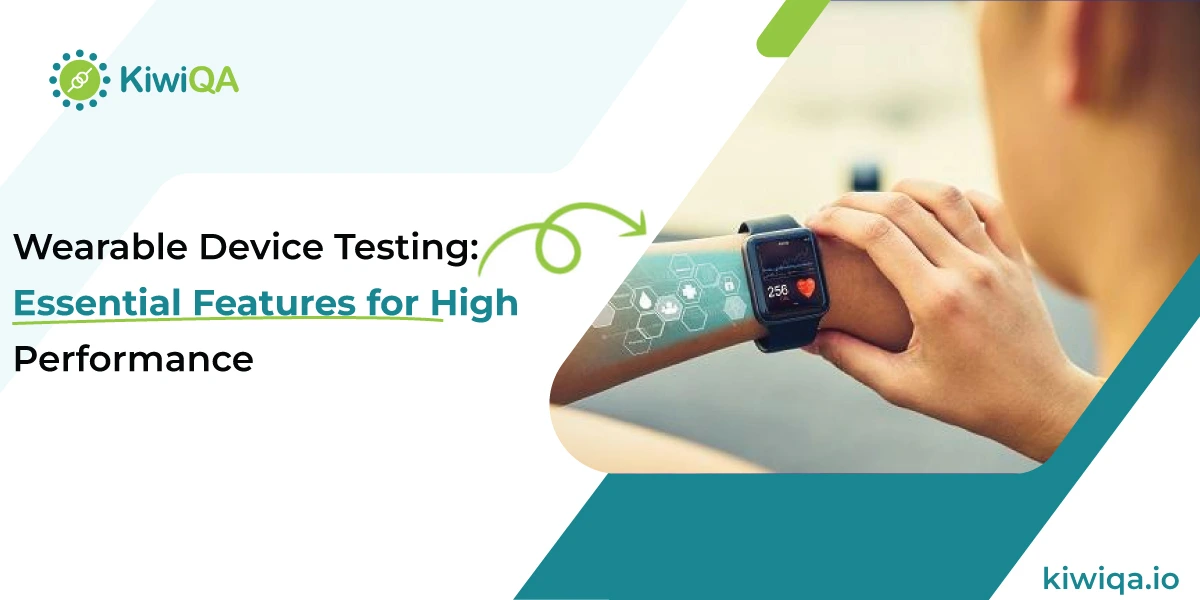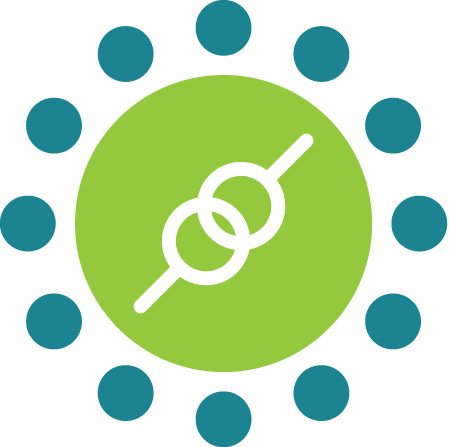Wearable Device Testing: Essential Features for High Performance

 KiwiQA
KiwiQATable of Contents
Wearable devices are all the rage now because who does not want to wear a piece of technology on one’s wrist or body? Wearable devices have the power to make things simple and create an IOT ecosystem for people. The Internet of Things market is set to reach the mark of $340 billion by 2024, and wearable devices are a huge part of this segment.
With the rise of the internet and the use of device capabilities, it is possible to create lightweight and wearable devices that can be multi-purpose and very easy to use. With smartwatches, tags, and other devices entering the wearable market, it is very important to create a wearable that is truly useful and very safe for users.
It is very crucial to provide people with the most advanced wearables so that they can get something novel to use. For a competitive edge, you need to depend on wearable app testing services. Choose a reliable wearable app testing services provider that knows the essential wearable tech testing features to focus on.
Dependency on wearable app testing services is crucial because it allows you to create reliable wearables that people will love using. To offer a wearable device that is dependable and useful for customers, you need to hire a company that knows about the Wearable technology testing essentials.
Wearable technology testing is important to check for all the features and specifications of a wearable device. It is also done to check if it has proper device compatibility with different devices. A company that caters to a wide audience base also has to meet the expectations of its customers.
In order to meet expectations and industry standards, it is important that the wearable testing team remembers the essential wearable tech testing features and checks them properly. Only with thorough wearable testing services can the company ensure that it floats an accurate and very high-performance wearable device for the audience.
Focusing on wearable device quality testing features also ensures that the wearable device is adapted and used right from launch. Wearable technology testing reduces the risks and issues linked with a wearable device so that there are fewer complaints and recall occasions for the developed wearable device. Let us understand that a considerable amount of money and resources go into wearable device development. To ensure that these investments bring in profits, it is important to create wearables and then test them thoroughly.
Essential wearable tech testing features are important for making sure that the device is high-performance and ready for the market. The features and make of a wearable are important to check so that the device is durable and reliable. In this article, you will learn about the top wearable device testing features and how to test them using best practices for wearable device testing. Before wearable technology testing, it is important to know the Wearable technology testing essentials, so you know how to direct your wearable testing team.
According to Caltech magazine, there have been many developments in wearable biosensors that allow companies to develop highly accurate and adaptable wearables. Wearable devices are now able to monitor a person’s health vitals in real-time. There are sensors that can gauge the amount of sweat a person is producing and can predict his health state accordingly.
Moreover, when sensors are combined with machine learning technology, companies can create wearable health devices that can do multi-modal sensing for different biomarkers. Such accurate biosensors can now fit into the space of 2mm square. A wearable testing team has to use its skills to check for the level of accuracy these sensors have.
Apart from the functional parameters of the wearable device, it is also important to check the data algorithms and predictive analytics code that give the wearable the data to function. The testing team has to focus on one of the essential wearable tech testing features, the database integration the device has in the cloud space. For this, the device testing team has to conduct Wearable device functionality testing and integration tests.
A wearable device has to be just that, perfectly wearable. A testing team for wearables has to look at this aspect as one of the Wearable technology testing essentials. The user should feel the utmost level of comfort when using the device on his body. The device should have a comfortable fit. Moreover, the user should be able to wear it for a long time without any problem. Durability and fit are some of the most important testing features for wearable devices.
In order to make sure that the wearable device is actually durable and can be worn by people for a long time, the wearability testing team should check the material with which the device is made. The device should be made with skin-friendly material and non-reactive material so that it does not lead to allergies and rashes.
The material for the wearable should be water resistant and resistant to environmental stress so it can be used as a part of the human body and not like an alien object. The team also has to do durability tests to ensure that a wearable can last for years and still work perfectly fine.
One of the major wearable device testing features is how the device connects with other devices. Wearable devices usually come with wireless and Bluetooth connections that have to always remain on. The wearable testing team has to check the network connectivity and Bluetooth connections made with the wearable device.
The team has to check for compatibility with other devices that people usually use. For example, the wearable app has to be on the person’s phone or tablet. So, the team has to check how easily the device can sync with the wearable and can transmit accurate data between the devices. The data connections and transmissions should be very quick and rapidly updated.
During wearable device functionality testing, the testing team also has to look at the compatibility of the wearable software with other devices. Every device runs on an operating system. The system of the smartwatch or any wearable should be aligned and compatible with the mobile operating system or that of the tablet. The most used operating systems for modern devices are Android, iOS, and Windows.
The wearable software should be able to function in conjunction with these operating systems without any issues. There should not be any latency issues, glitches, or malfunctions between the app and the wearable device. Moreover, the wearable device should also remain open to security upgrades, software upgrades, and troubleshooting. This concurrency should be maintained at multiple levels so that the wearable can work with any of the smartphones and tablets in use today.
The wearable device has to be very small and lightweight to be truly adapted to human usage. People want to see the novelty of tiny wearables that can get a lot of things done for them. The wearable technology testing team has to ensure that the wearable is responsive and interactive despite its small size.
The testing team needs to check that all the controls and icons of the wearable device are working properly. The response time should be shorter, and the gesture reaction should be fast. The team has to test the navigation and its ease through usability testing. The controls and layout of the wearable UX design need to be tested.
The icons and text should be visible and readable so a user can take action. The button functions also need to run through the Wearable device functionality testing cycle. Moreover, these days, wearables are integrated with VUI or voice command interpretation, which also needs to be tested for their responses and quick reactions. The voice reactions should be understandable to the users.
The wearable technology testing team usually picks out small user groups that represent the larger population and then runs checks of the wearable device on multiple groups so that the usability of the device is verified. The testing team runs beta testing cycles to see that the wearable devices and apps are very easy to use for the actual audience segment.
When checking for Wearable technology testing essentials, the team also has to check for the overall performance of the device. The testing team has to see if the wearable device can multi-task and open multiple modules quickly. It is important to check if the wearable device software can handle higher load and frequency of actions.
The team has to run the app and the device through different stress factors to ensure that the device is durable and usable in different conditions. The device should be able to handle fluctuating environmental conditions. The wearable should not be highly reactive to heat or humidity.
The device should be heat stable and can work smoothly in different physical conditions. Performance and stress testing ensures that the device does not explode or cause harm to the person wearing it. The wearable testers should also check the scalability of the app and the device so that the device can remain responsive under varying traffic loads.
The wearable device security market is all set to increase in value by 16 percent in the coming years. This is important to note as the adoption of wearable devices and other smart devices is slowly increasing. For example, the adoption of smartwatches and their user segment has been increasing at an 18 percent rate in recent years. With the increase in the number of users, producers have to keep in mind that more people are exposed to the threat of cyber security attackers with wearables.
While the basic security provisions of data encryption and authentication are present around most wearables, it is important that a manufacturing company also takes note of the proximity-based risks that wearable security has from external agents. Most of the risks arise when these wearables connect with a new network or data migration on a large scale.
Therefore, the wearable testing team has to check data encryption and other aspects of the security algorithms. The wearable development team and the wearable testing team have to pay attention to the current rules regarding data privacy. As the healthcare sector is the leading sector of wearable production, compliance regulations should include GDPR and HIPAA as the rules to adhere to.
For a wearable testing team, the wearable device and app are the product. The team has to check the device’s physical and software specifications. Wearable app testing experts know that the demand for wearables and their responsibility has only increased. A good wearable testing team has to consist of experts and professionals who can create novel testing parameters for evolving wearables.
Compatibility, durability, and biosafety are some of the major aspects of a wearable device. Apart from the essential features, a good testing team also checks for additional features and details of the wearable. If you are coming up with a new wearable, you should also look for a good wearable testing team that has experience in handling multiple test cases for previous clients.
Join the like-minded community & get the latest updates and insights on software testing technological transformation around the globe. Don't miss out.
